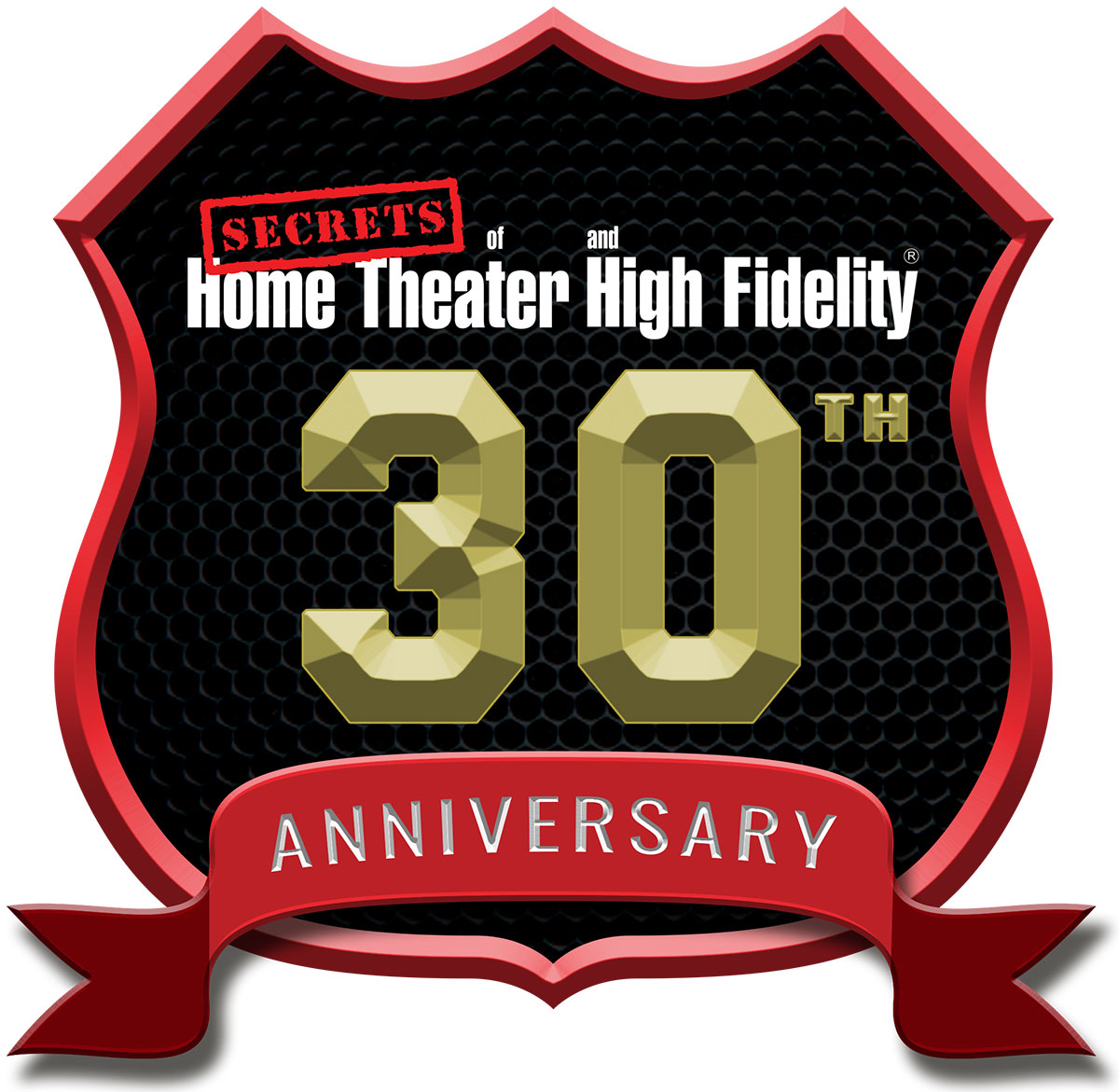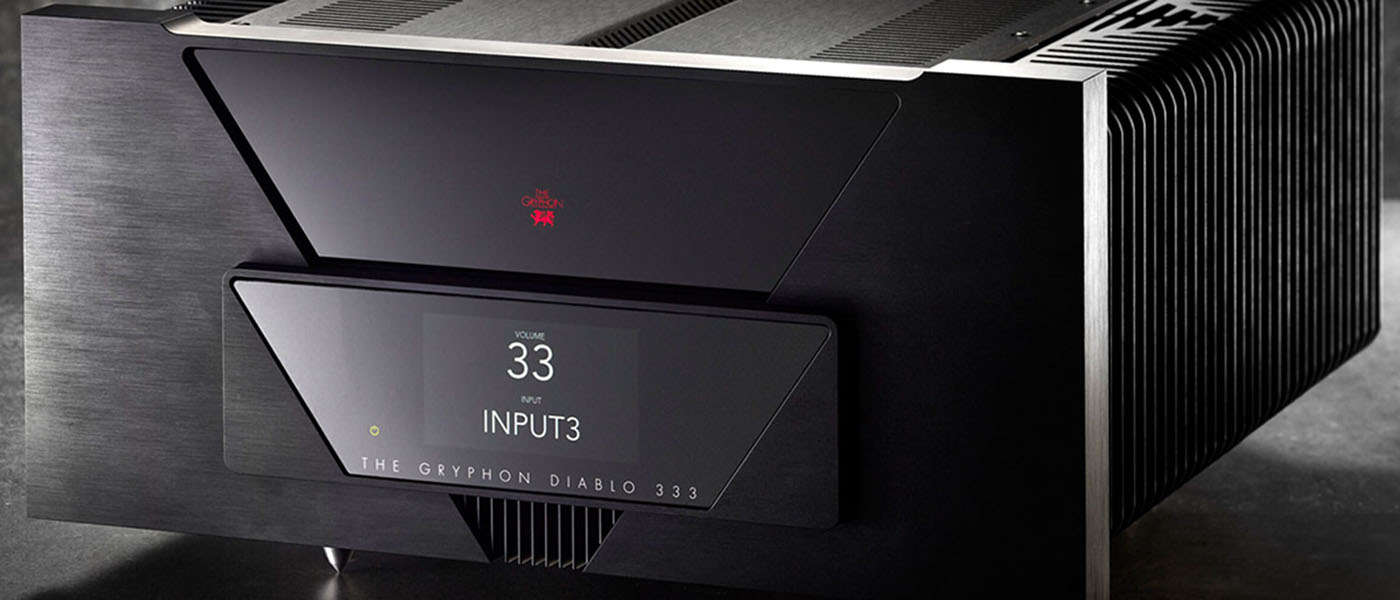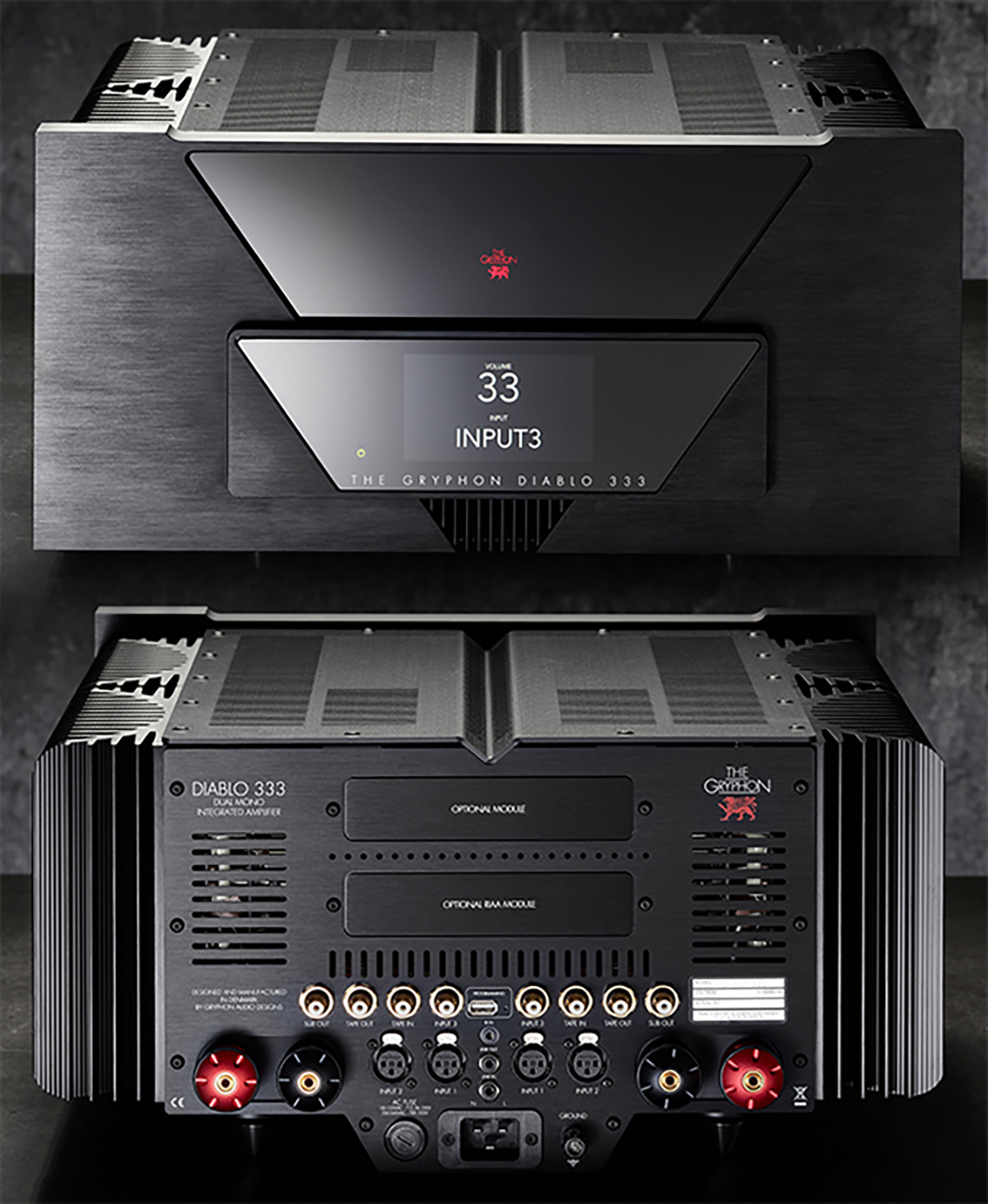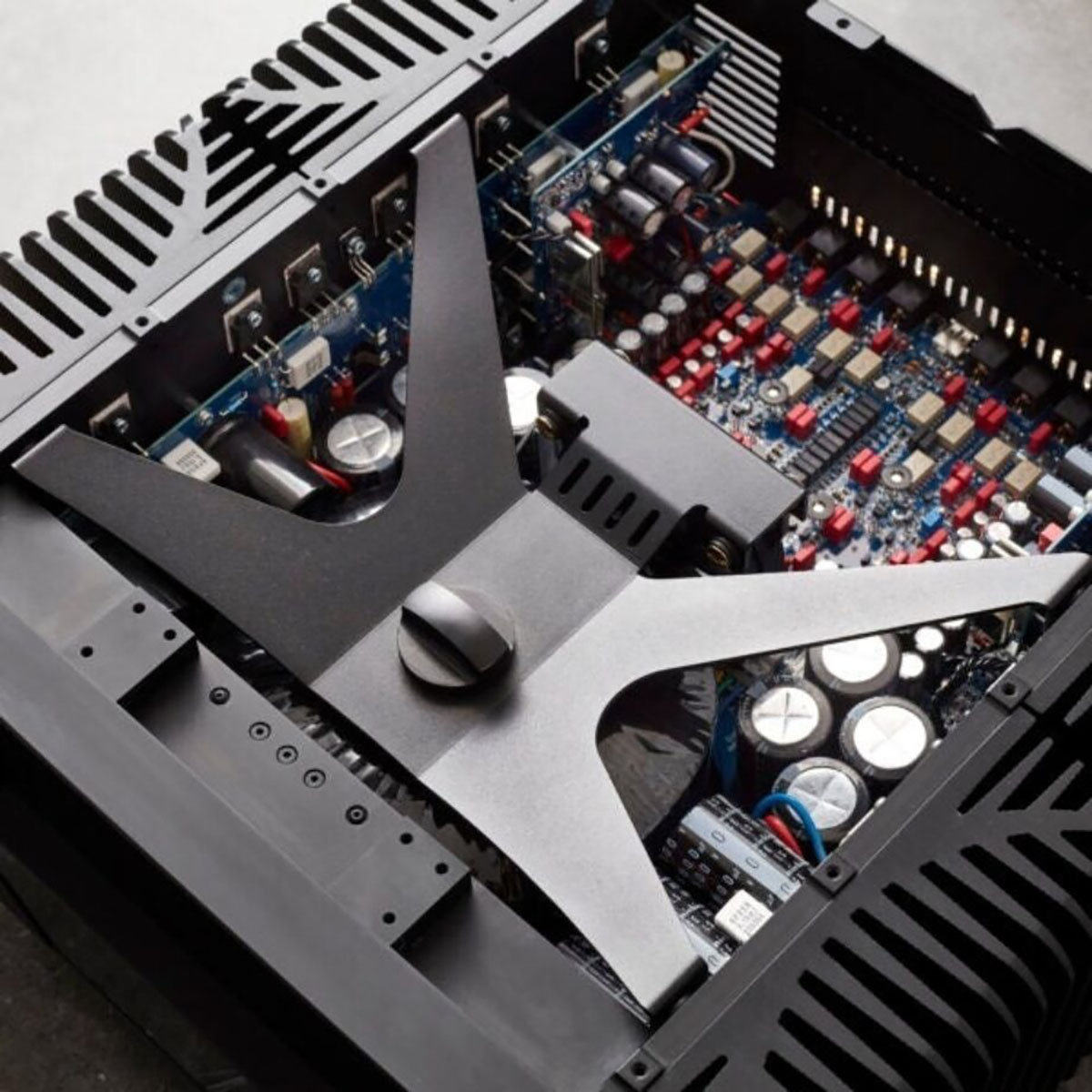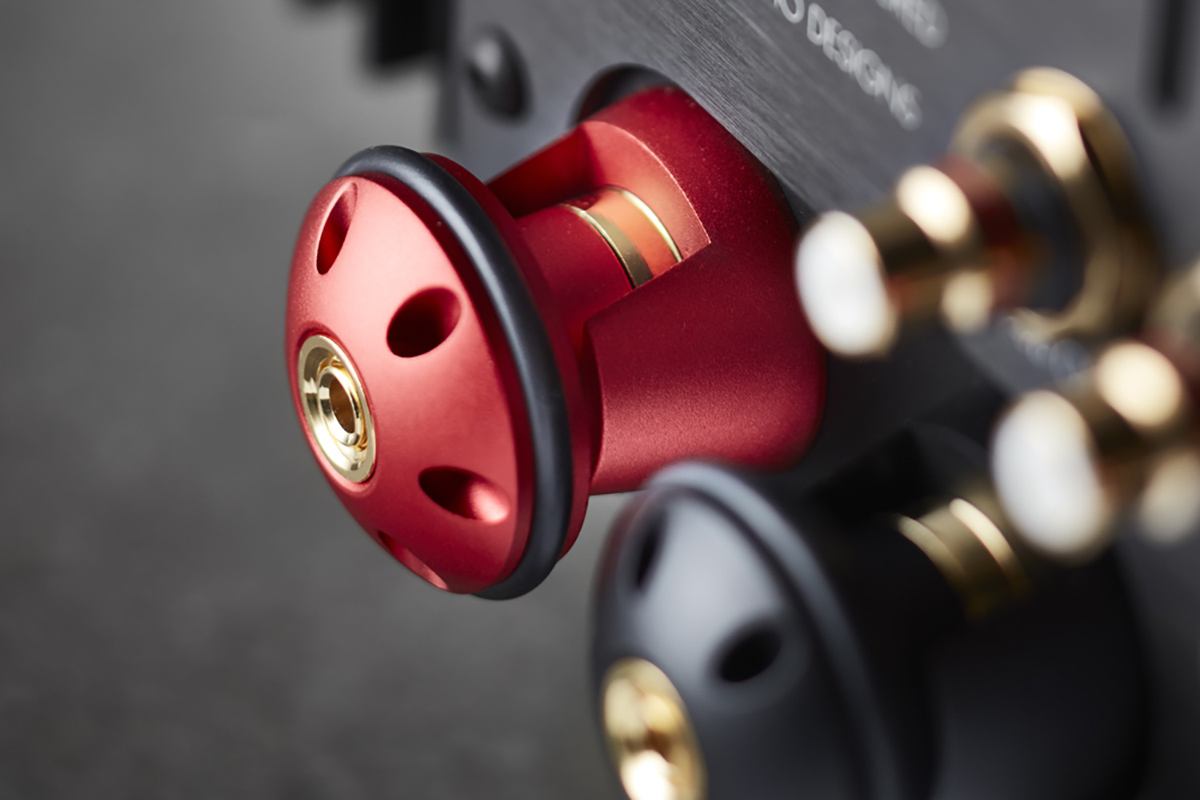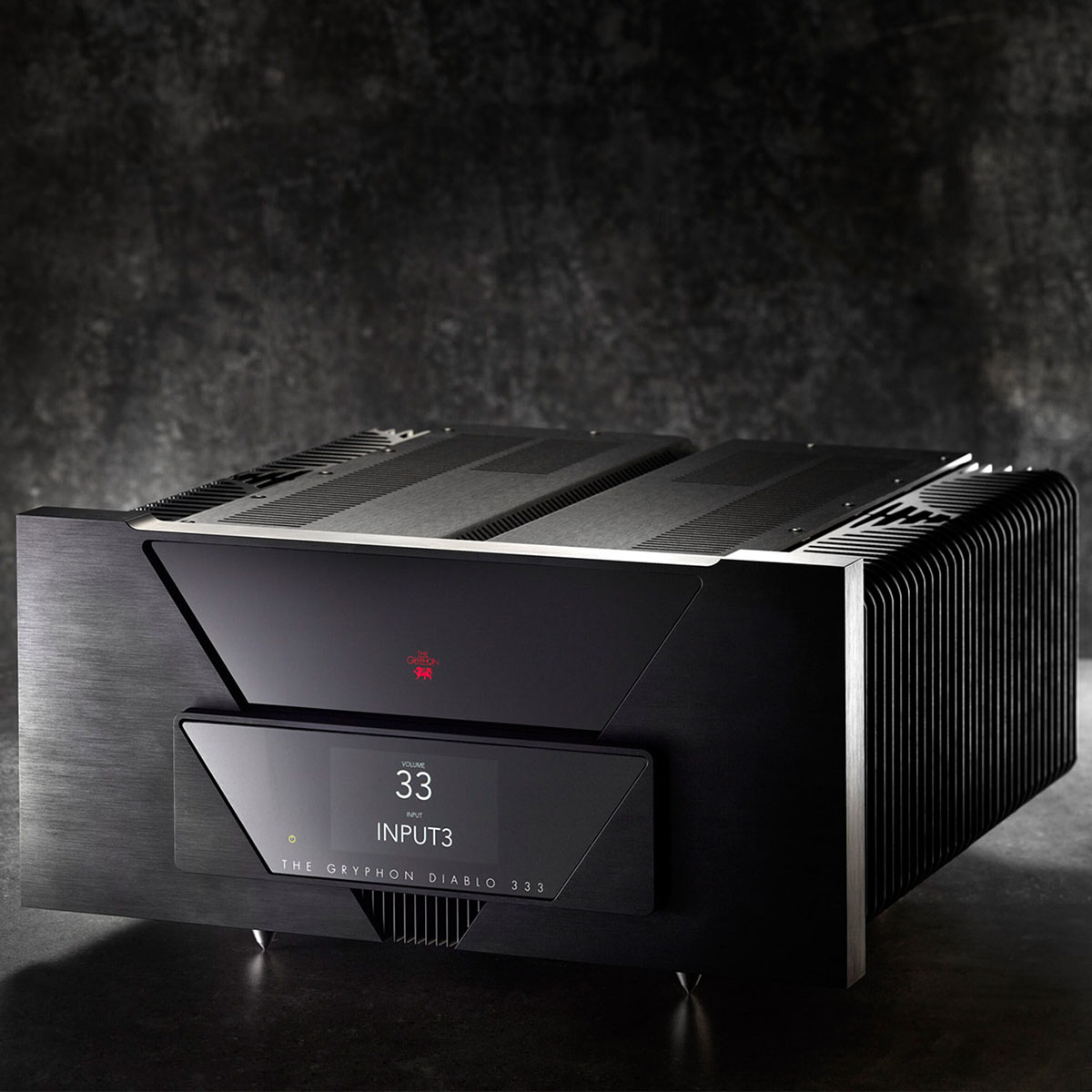In this case, entry-level does not have the usual meaning, as it is a powerhouse of an amplifier with a price tag of $25,000.
Weighing in at 112 pounds and rated at 333 watts per channel into 8 ohms, 666 watts per channel into 4 ohms, and 1,100 watts per channel into 2 ohms, the Diablo 333 is a serious class A/B amplifier which should be able to drive almost any speaker imaginable. It does not attempt to hide its masculine rendering of a brutish audio product. In use, it is to audio what a 1,000-horsepower Dodge Challenger Hellcat is to a passenger car.
Gryphon Audio Diablo 333 Integrated Amplifier Highlights
- True Dual Mono configuration.
- Zero global negative feedback.
- Microprocessor-controlled 43-step true balanced relay volume attenuator for best sonic performance featuring only 1-2 resistors in series with signal at all levels.
- Ten high-power output transistors in each channel.
- Diablo 333 utilizes new ultra-fast, low-capacitance pre-driver transistors.
- Polypropylene capacitors for local power supply decoupling.
- Optional phono stage module, PS3 MM/MC.
- Optional DAC3 module with one USB, 2 x SPDIF, 1 AES and 1 optical input.
- Ultra-short signal path.
- Minimal internal wiring.
- Four-layer printed circuit boards with 70μ copper on all layers.
- Dual Mono Holmgren toroidal transformer.
- PCB-mounted sockets eliminate wiring and shorten the signal path.
- Gold-plated Neutrik XLR sockets for two balanced sources.
- Gold-plated phono sockets with Teflon insulation for two inputs and two outputs.
- Gold-plated Gryphon custom-built binding posts.
- Fixed-level AV throughput for uncompromising integration with surround preamplifier (aka home theater bypass).
- Input level matching
- 4.3” TFT capacitive touch screen with 4mm hardened glass in front.
- Intuitive menu structure.
- 12v DC link input and output.
- Infrared Receiver input via input on the rear panel.
- Firmware upgradeable via USB 2.0 socket on rear panel.
- Non-invasive protection system.
- Infrared remote control.
- Standby power consumption < 0.5W.
- Designed and built in Denmark.
- The ability to bring almost any loudspeaker to its knees.
- Exterior design by Flemming E. Rasmussen.
- Electronics design by Tom Møller.
The Gryphon is a mythical creature from ancient Greece, combining the body of a lion and the head and wings of an eagle. Of course, this would be an intimidating animal, and the use of the name by Gryphon founder Flemming E. Rasmussen was quite purposeful. Rasmussen founded the company in 1985, with the first product being a head amp which was the object of international acclaim.
Before long, Gryphon entered the arena of uber-high-end pre-amplifiers and power amplifiers. For over three decades, the company has developed a well-earned place in the arena of high-end audio with products that deliver gobs of power with a great deal of finesse. While $25,000 is not inexpensive, the Gryphon Diablo 333 Integrated Amplifier combines an excellent pre-amp and power amp into a single chassis. In terms of high-end audio, it looks to be a solid value. We will be putting this to the test.
Power output:
2x 333W@8Ω, 2x 666W@4Ω, 2x 1,100W@2Ω
Output impedance:
0.015Ω
Bandwidth (-3dB):
0.1Hz to 350kHz
Power Supply Capacity:
2x 68,000uF
Gain:
+38dB
Subwoofer output gain:
+12dB
Input Impedance, balanced (20-20000Hz):
50KΩ
Input Impedance, single-ended (20-20000Hz):
30KΩ
Power consumption:
≤ 0.5W (standby), approx. 180W (idle)
AC voltage range:
110-120V OR 220-240V – not changeable
Outer dimensions, W x D x H:
468mm x 472mm x 245mm / 18.4in x 18.6in x 9.66in
Net weight:
50.6kg / 112 pounds
Basic Diablo 333 Integrated Amp Price:
$25,000 USD
Optional DAC Price:
$7,000 USD
Optional Phono Input Price:
$7,000
Website:
Company:
SECRETS Tags:
gryphon audio, diablo 333, integrated amplifier, two-channel amplifier, stereo amplifier
- Rotel MICHI X5 Series 2 Integrated Amplifier Review
- Advance Paris A12 Classic Integrated Amplifier Review
- Pathos Lògos MkII Integrated Amplifier Review
Secrets Sponsor
The Diablo 333 is as straightforward an integrated amp as one could ask for. It’s a Class A/B design, with everything about its engineering being a textbook example of overbuilding a product with an eye towards performance and a long shelf life. Our test unit is the basic amplifier without the optional DAC or phono input. The typical setup for the unit tested here would be a CD player and streamer into either the two RCA (unbalanced) or two XLR (balanced) inputs. One could also use one of the RCA inputs for a home theater bypass.
It also has dual RCA outputs dedicated to subwoofers, should one want to add subs to a high-end system. The build quality is as good as it gets in the audio industry, right down to some of the finest speaker connectors one can find. These connectors can easily handle almost any size speaker wire and make everything from bare wire to banana plugs to spades a simple task.
The quad spiked feet (much like the spikes one would see in high-end floor standing speakers) did make wrestling the amp into our cabinet a challenge (we used protective discs from a pair of high-end speakers to protect the wood), but this is more of a reviewer problem than an end user issue. Your dealer will be happy to install this 112-pound beast for you. It would not look out of place to put the Diablo 333 on a dedicated amplifier rack.
The front of the amplifier is ruggedly handsome, with the large screen making it easy to see which input was selected along with the current volume level. The back panel adds a USB input for programming purposes along with a 3.5mm input for a cabled remote and a 3.5mm socket to provide power switching for other audio products. The entirety of the design of the Diablo 333 integrated is a no-nonsense audio product that has almost no limits in real-world conditions. Into most speakers, it can deliver roughly 1,000 clean watts of power. One’s home electrical capacity will likely be the limiting factor with Mr. Diablo.
The Diablo 333’s setup was relatively simple. For the purpose of this review, it was plugged into the high-power port of our Clarus Concerto power conditioner using the supplied power cable from Gryphon. The Clarus Aqua high current power cable we normally use would not fit into the Gryphon’s 15A IEC socket. This did not seem to have any effect on the delivered performance, and the fit of the supplied power cable into the IEC socket was perfection: snug to the point that there were no worries about it becoming unplugged easily. A Yamaha CD-2100 S CD/SACD player and our venerable OPPO 105 universal player were plugged into the XLR input of the Diablo 333 using the Clarus Aqua XLR source cables. The Yamaha was plugged into the Clarus Aqua’s digital equipment input using a Clarus Aqua power cable.
For speakers, a pair of Clarus Aqua speaker cables finished the system between the Diablo 333 integrated amplifier and a pair of Diptyque Audio 140 Mark II planar loudspeakers. The 140 Mark IIs were selected as they are relatively low in sensitivity while providing a challenging amplifier load to any power amp. They are also ruthlessly revealing of any amplifier (or other upstream issues) and can deliver bass to the upper 20 Hz range, unusual for an isodynamic loudspeaker. Secrets of Home Theater and High Fidelity reviewed the Diptyque 140 Mark II here.
The remote control makes the Diablo 333 a snap to use. As mentioned earlier, the Gryphon Diablo 333 was going to be tested as a minimalist integrated amplifier. There would be no extra frills, and as the listening sessions were getting prepared, I noticed that even looking at the front panel was a treat. Even though they have nothing in common in terms of their appearance, the Diablo 333 took me back to 1980 and a Marantz 510M power amplifier with a matching 3600 pre-amplifier. Both are masculine to an extreme, heavy and exude a promise of exceptional power. They make no apologies for their brute strength, and each throws out the aura of a superheavyweight boxer getting into the ring. With that in mind, the decision was made to spend a considerable amount of time finding out just how capable the Diablo is.

Supertramp: “Breakfast in America”
Released in 1979, ‘Breakfast in America’ was one of the earliest vinyl albums I used for auditioning speaker systems. Later, once finding a CD player that moved me from vinyl, I replaced the album with the CD. It offers excellent dynamics, a variety of synthesized music, vocals, and live instruments. The kick drum is powerful and deep to go along with soaring vocals, deft guitar work, and revelatory keyboards.
The opening track, ‘Gone Hollywood’, starts with an exceptionally quiet piano which gradually gets louder until the drums and guitars announce rather loudly the show is beginning. This intensity is matched on many occasions throughout the disc, and the Gryphon amp had no problem bringing its gravitas into the listening room through the planar Diptyques. The amount of detail that this system can reproduce was immediately apparent, and it was time to settle back and drink it all in.
The next two tracks (The Logical Song and Goodbye Stranger) work in tandem with Gone Hollywood to form a trifecta of powerful rock and roll history which one would normally associate with a pair of JBL towers or Klipsch corner horns. The amount of sheer power and air guitar-inducing fun from this system was immediate proof that this was no polite system requiring the caveat of ‘within its limits’ when playing driving, challenging rock music. Tracks 4 to 9 slow things down with more of a ballad feel from songs such as ‘Take the Long Way Home.’
Then we finish with ‘Child of Vision’, which expands on the explosive trio that opens the CD. ‘Child of Vision’ is an underrated rock and roll manifesto with some of the best-recorded drums ever. The keyboard work is first-rate, and throughout the 7.5 minutes of pure fun, the Diablo/Diptyque combination was nothing short of magic. The Diablo 333 was already proving why people marvel over how Gryphon’s amps can drive even the most demanding speakers to new highs (and lows).
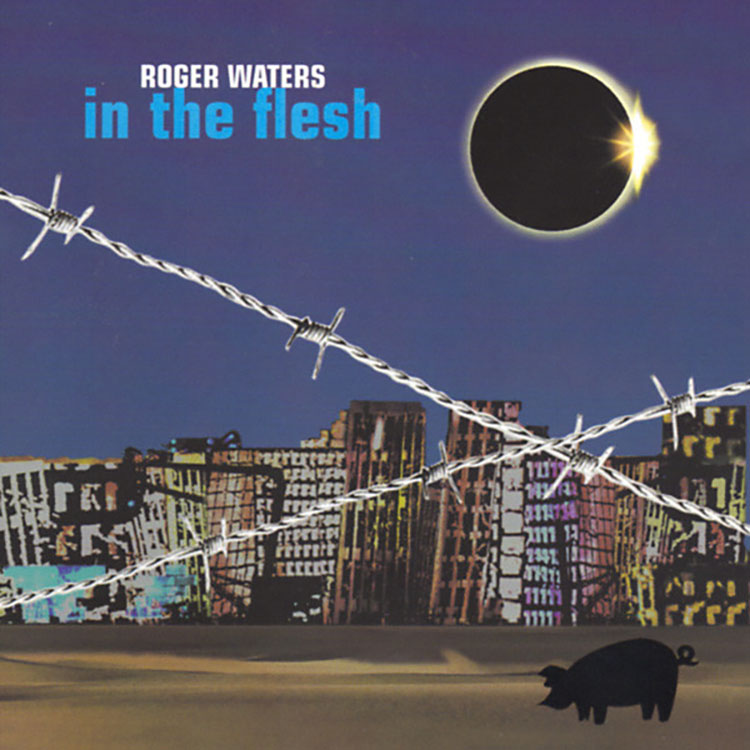
Roger Waters: “In The Flesh” SACD
Few recordings can challenge an audio system as well as this two-disc set from over 20 years ago. The opening track is the name of the album, and it requires an abundance of raw horsepower to transport the listener into the performance. When one thinks of planar-style speakers such as the Diptyque 140 Mark II, extreme macro-dynamics are not the first things that come to mind.
With the excellent Yamaha CD-2100S providing the signal, the Diablo 333 bringing the horsepower into the planar speakers was something I approached with a bit of caution. Into these speakers, the Diablo 333 can deliver well in excess of 600 watts per channel. The last thing I wanted was the destruction of the woofer panels in a pair of $17,000 loudspeakers. After playing around with the volume control, it became quite apparent that this combination of high-class A/B power and the ultra-lightweight woofer panels not only did well, but the Diablo also took these planar speakers into a level of Sound Pressure Level (SPL) that was borderline scary.
After reassuring myself that the Diptyques could take it, we fired up this concert with the explosive entrance of the title track ‘In The Flesh.’ The drum crescendo at the beginning exhibited some real in- your-face volume. The infamous helicopter track had an incredibly adept percussive thwack, with each blade clearly delineated. The transition into ‘Another Brick in the Wall, part 2’ brought a new level of deep bass to the Diptyques. It was lightning quick yet powerful, without a hint of overhang.
Track after track was awe-inspiring, with the guitar work on ‘Mother’ having the proper sense of weight of the body with the agility of the strings bringing realism to the performance. ‘Welcome to the Machine’ and ‘Shine on You Crazy Diamond’ were menacing when required and uplifting when desired. The vocals in ‘Shine,’ particularly the chorus, were focused to the point that each voice was clearly heard. ‘Time’ actually jolted me out of the relaxed state that the previous 30 minutes placed me in. By the time we got to ‘Comfortably Numb,’ I found myself wondering just how impressive the Diablo 333 would be with the Diptyque Reference speaker, with its 6-9 dB more available output and half octave of increased bass extension.
The Diablo 333 was well on the way of demonstrating it could take even a planar speaker and turn it into a concert maker. The next task: how well can this brute of an amplifier handle more delicate music?
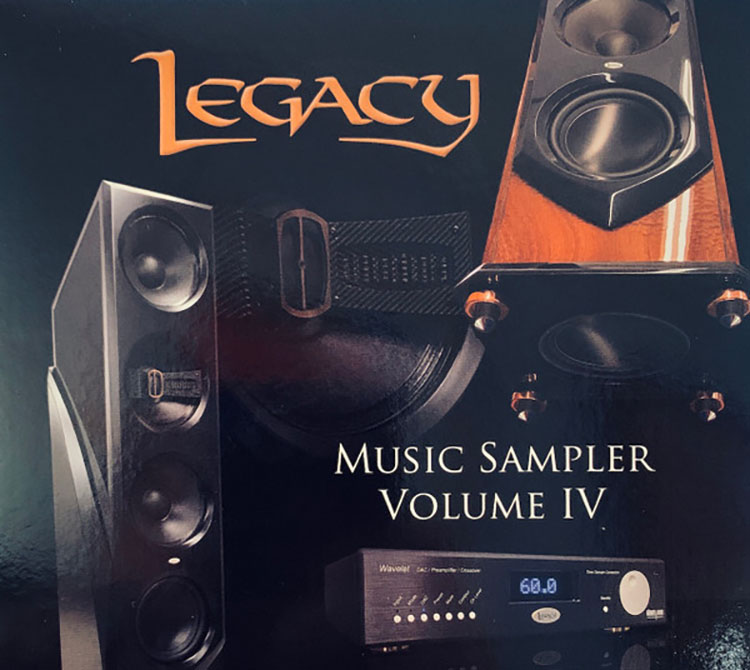
Legacy Audio Music Sampler Volume IV
Legacy Audio not only makes terrific audio equipment (Their Focus XDs were Secret’s loudspeaker of the year for 2023. The only reason the Focus XDs were not also featured with the Gryphon Diablo 333 is that their high sensitivity and powered woofer section are too easy a test for this amp), they also have put together a series of music sample CDs that are an audio reviewer’s dream. The latest compilation is a continuation of this service to the audio community. Out of the 15 tracks, we concentrated on three.
Cello Suite No. 3 in C Major, BWV 1009: I. Prelude by Johann Sebastian Bach, Richard Narroway: The rendering of the cello in this track is one of neutral sonics. There is no emphasis on bass as is normal in today’s recordings. It is one of the most accurate portrayals of a Cello one can find for reproduction. The Diablo hit the leading edge of each note with all the quickness one would experience live. The bow’s hitting the body was easily heard. The bass notes were agile and natural. The Diptyques, as with most well-designed planar speakers, are made to make this type of unamplified music into a performance in one’s room, and the Diablo 333 was nothing short of stellar on this track. It was remarkably close to the all-tube Rogers KWM-88 integrated amp in terms of musicality on this and the next two tracks.
Harp Sonata: III. Vivo by Pierick Houdy, Sarah Schuster Guard
At Capital Audio Fest 2022, we were treated to a lovely young lady playing the harp live for us in a pretty quiet area. At the time, our editor-in-chief Carlo Lo Raso and yours truly relished her playing as one of the best sounds of the show. As with the cello, the reproduction of this harp was wonderfully done through this system. Each note had the heft combined with delicacy as required by a harp. It was so well done that I hit repeat just to ensure that my first impressions were not overwhelming my objectivity. They were not. The Diablo 333 again showed it was not all about brute force.
String Quartet No. 30 in E-flat Major: Allegro moderato by Franz Joseph Haydn, Spektral Quartet: The third track treated us to a quartet of strings that not only required a deft touch: it also had impressive macro-dynamics. Attending a quartet such as this live will impress one with how potent and just plain loud four-string instruments can play. A good system will allow one to enjoy each instrument’s participation in the performance as an individual piece while also bringing them together in an immersive performance. The Diablo handled this with ease. If you are a fan of a system that will take real instruments and bring them into your room, The Gryphon amp can be a solid component for anchoring such a system.

How to Train Your Dragon
You may have noticed the inclusion of the OPPO 105 universal player in the setup portion of this review. After the Gryphon Diablo 333 demonstrated it could drive the Diptyque 140 Mark IIs on a variety of music tracks, it occurred to this reviewer that many well-heeled audiophiles might also want to get a feel for how well the big amp could do with one of the most difficult movie soundtracks in existence. ‘Dragon’ has been a staple for testing home theater systems for years, and with good reason. It has a constant orchestral backing to the dialogue and sound effects along with… dialogue and sound effects galore.
The story centers around Hiccup, a teenager trying to prove his worth to his beyond-masculine father and other Viking leaders. He manages to capture and eventually become friends with Toothless, the dreaded Night Fury dragon that his father and other leaders consider to be their mortal enemy. It is animation at its best, and the soundtrack presents a challenge to any loudspeaker.
Early in the movie, there is a training scene in which Hiccup and the other teenagers are locked in an arena with a variety of dragons, with one challenge: to survive. As the various dragons attack the intrepid teens, the sound effects are in abundance. Deep thuds as one would expect when a 2000- pound beast slams into a wall combine with sharp thwacks as the kids use shields to fend off the attacks. Here we were, tormenting a pair of planar speakers with extreme dynamics and wallowing in deep bass, lightning-fast transients, and a musical score that was soaring above it all.
As the movie progresses, we find the central theme is that dragons and humans are not enemies after all. This has been a grave error, and one which Hiccup discovers, but he must (along with his personal dragon, Toothless the Night Fury) convince the leaders of this. There is another threat, a dragon of immense size, and Hiccup convinces his dad that this immense dragon, along with all other dragons, must be slain. Hiccup warns the leaders that they cannot defeat this dragon, but he is, of course, ignored. The village leaders put together an armada to find this ultimate beast to destroy it.
They find this beast, only to also find the dragons are also terrified of it. It is the size of 1,000 dragons and as it emerges from its cave, the bass is of the floor-shaking type. The Diptyque speakers are known for their bass, especially for planar speakers. Even knowing this, the performance delivered through The Gryphon amp was nothing short of astonishing. Without letting out any more spoilers, this final battle scene is a test for even the largest of multi-subwoofer theater systems. While this two-channel combination did not deliver the infrasonic bass notes, the bass from 30 Hz and up was powerful, impactful, and tight.
This performance was so well done that a list of speakers I would love to hear with this incredibly powerful amp began to form. Gryphon’s own Trident II, Bowers and Wilkins 801 D4 signature, Legacy Audio Focus SE, Perlisten Audio S7T, DALI core, and various models from PBN loudspeakers come to mind. Put simply, I cannot imagine a loudspeaker that the Gryphon Diablo 333 could not drive. The small list here (and there are many examples I missed) are all speakers with a response to below 20 Hz. A two- channel system with any of these speakers, anchored with the Diablo 333, will deliver bass to well below 20 Hz without a hint of dynamic limits. Combining this level of power with the accuracy, sound stage, and delicacy that the big amp demonstrated throughout this test proves that the Diablo 333 is not just a tremendous product, it is a real value in today’s ultra-high-end systems.
Secrets Sponsor
The Gryphon Diablo 333 is a statement integrated amplifier that would not be out of place driving speakers costing 10 times its $25,000 price.
- Class A/B design.
- High-end pre-amplifier and power amplifier in one chassis save on space and interconnect cost.
- Show it off to your friends, good-looking.
- Seemingly unlimited power.
- Incredibly quiet noise floor.
- High-end remote.
- Build quality that is a Gryphon hallmark.
- Choice of your own DAC or using the optional DAC from Gryphon.
- Choice of your own Phono pre-amp or using the optional unit from Gryphon.
- Deep and wide sound stage.
- What it can do with a pair of speakers capable of linear response to below 20 Hz.
- Someone else carrying it.
The Gryphon Diablo 333 is an end-game product. While it is not the most expensive product in The Gryphon family of amplifiers, it does pose the question: Why spend more? It has no practical limit in terms of the power it can deliver to any speaker one can imagine. The Gryphon folks have managed to deliver an amplifier that is as bombastic as one could ever want while being as delicate as a butterfly when the music demands it. At no time did I find myself thinking ‘I wish this amp would do more.’ This is a state-of-the-art product for a realistic price. I will hate to see this review sample going back.



